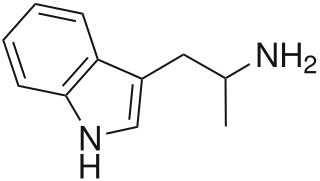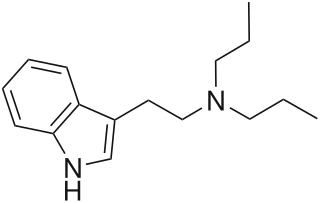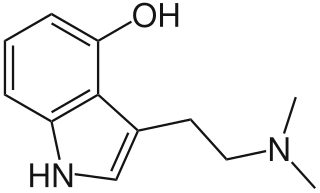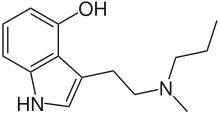
α-Methyltryptamine is a psychedelic, stimulant, and entactogen drug of the tryptamine class. It was originally developed as an antidepressant by workers at Upjohn in the 1960s, and was used briefly as an antidepressant in Russia under the trade name Indopan before being discontinued.

N,N-Dipropyltryptamine (DPT) is a psychedelic entheogen belonging to the tryptamine family. Use as a designer drug has been documented by law enforcement officials since as early as 1968. However, potential therapeutic use was not investigated until the 1970s. It is found either as a crystalline hydrochloride salt or as an oily or crystalline base. It has not been found to occur endogenously. It is a close structural homologue of dimethyltryptamine and diethyltryptamine.

4-Hydroxy-N,N-diisopropyltryptamine is a synthetic psychedelic drug. It is a higher homologue of psilocin, 4-HO-DET, and is a positional isomer of 4-HO-DPT and has a tryptamine molecular sub-structure.

Psilocin is a substituted tryptamine alkaloid and a serotonergic psychedelic substance. It is present in most psychedelic mushrooms together with its phosphorylated counterpart psilocybin. Psilocin is a Schedule I drug under the Convention on Psychotropic Substances. Acting on the 5-HT2A receptors, psilocin modulates the production and reuptake of serotonin. The mind-altering effects of psilocin are highly variable and subjective and resemble those of LSD and DMT.

Diisopropyltryptamine is a psychedelic hallucinogenic drug of the tryptamine family that has a unique effect. While the majority of hallucinogens affect the visual sense, DiPT is primarily aural.

DET, also known under its chemical name N,N-diethyltryptamine and as T-9, is a psychedelic drug closely related to DMT and 4-HO-DET. However, despite its structural similarity to DMT, its activity is induced by an oral dose of around 50–100 mg, without the aid of MAO inhibitors, and the effects last for about 2–4 hours.

4-HO-DET, also known as 4-hydroxy-diethyl-tryptamine, CZ-74, is a hallucinogenic drug and psychedelic compound of moderate duration. 4-HO-DET is a substituted tryptamine, structurally related to psilocin, ethocybin, and 4-HO-DIPT.

5-MeO-MiPT is a psychedelic and hallucinogenic drug, used by some as an entheogen. It has structural and pharmacodynamic properties similar to the drugs 5-MeO-DiPT, DiPT, and MiPT. It is commonly used as a "substitute" for 5-MeO-DiPT because of the very similar structure and effects.

4-Acetoxy-DiPT is a synthetic psychedelic tryptamine. It is relatively uncommon and has only a short history of human use.

ALD-52, also known as 1-acetyl-LSD, is a chemical analogue of lysergic acid diethylamide (LSD). It was originally discovered by Albert Hofmann in 1957 but was not widely studied until the rise in popularity of psychedelics in the 1960s.

4-HO-MiPT is a synthetic substituted aromatic compound and a lesser-known psychedelic tryptamine. It is thought to be a serotonergic psychedelic, similar to magic mushrooms, LSD and mescaline. Its molecular structure and pharmacological effects somewhat resemble those of the tryptamine psilocin, which is the primary psychoactive chemical in magic mushrooms.

N-Methyl-N-isopropyltryptamine (MiPT) is a psychedelic tryptamine, closely related to DMT, DiPT and Miprocin.

2C-T is a psychedelic and hallucinogenic drug of the 2C family. It is used by some as an entheogen. It has structural and pharmacodynamic properties similar to the drugs mescaline and 2C-T-2.

AL-LAD, also known as 6-allyl-6-nor-LSD, is a psychedelic drug and an analog of lysergic acid diethylamide (LSD). It is described by Alexander Shulgin in the book TiHKAL. It is synthesized starting from nor-LSD as a precursor, using allyl bromide as a reactant.

PRO-LAD is an analogue of LSD. It is described by Alexander Shulgin in the book TiHKAL. PRO-LAD is a psychedelic drug similar to LSD, and is around as potent as LSD itself with an active dose reported at between 100 and 200 micrograms.

O-Acetylpsilocin is a semi-synthetic psychoactive drug that has been suggested by David Nichols to be a potentially useful alternative to psilocybin for pharmacological studies, as they are both believed to be prodrugs of psilocin. However, some users report that O-acetylpsilocin's subjective effects differ from those of psilocybin and psilocin. Additionally, some users prefer 4-AcO-DMT to natural psilocybin mushrooms due to feeling fewer adverse side effects such as nausea and heavy body load, which are more frequently reported in experiences involving natural mushrooms. It is the acetylated form of the psilocybin mushroom alkaloid psilocin and is a lower homolog of 4-AcO-MET, 4-AcO-DET, 4-AcO-MiPT and 4-AcO-DiPT.

2,N,N-trimethyltryptamine, 2,N,N-TMT, or 2-Me-DMT is a tryptamine derivative that is a psychedelic drug. It was invented by Alexander Shulgin and reported in his book TiHKAL (#34). It is claimed to show psychoactive effects at a dosage of 50–100 mg orally, but these are relatively mild compared to other similar drugs, suggesting that while the 2-methyl group has blocked the binding of metabolic enzymes, it is also interfering with binding to the 5HT2A receptor target that mediates the hallucinogenic effects of these drugs.

4-HO-MET is a lesser-known psychedelic drug. It is a structural− and functional analog of psilocin as well as the 4-hydroxyl analog of methylethyltryptamine (MET). 4-HO-MET was first synthesized by Alexander Shulgin. In his book TiHKAL, the dosage is listed as 10-20 mg. 4-HO-MET produces psilocin-like distortion of color, sound, and form. Very little data exists about the pharmacological properties, metabolism, and toxicity of 4-HO-MET. There have been no reports of deaths from 4-HO-MET, even though people have reported taking doses up to 150 mg, more than an order of magnitude above the effective dose.

4-HO-pyr-T (4-hydroxy-N,N-tetramethylenetryptamine) is a lesser-known psychedelic drug. It is the 4-hydroxyl analog of pyr-T. 4-HO-pyr-T was first synthesized by Alexander Shulgin. In his book TiHKAL, neither the dosage nor the duration are reported. 4-HO-pyr-T produces few to no effects. Very little data exists about the pharmacological properties, metabolism, and toxicity of 4-HO-pyr-T.

4-Hydroxy-α-methyltryptamine (4-HO-αMT) is a psychedelic drug of the tryptamine class. It is a close structural analogue of α-methyltryptamine (αMT) and produces similar effects to it, but with exacerbated side effects similarly to 5-MeO-αMT. Alexander Shulgin describes 4-HO-αMT briefly in his book TiHKAL:
The 4-hydroxy analogue of αMT has been looked at in human subjects. It is reported to be markedly visual in its effects, with some subjects reporting dizziness and a depressed feeling. There were, however, several toxic signs at doses of 15 to 20 milligrams orally, including abdominal pain, tachycardia, increased blood pressure and, with several people, headache and diarrhea.




















